A selection of the best honeysuckle varieties for central Russia
Honeysuckle is an unpretentious berry to grow, distinguished by its vitamin composition and tart taste. It quickly adapts to the climatic conditions of any region, is frost-resistant, and rarely gets sick. Honeysuckle is eaten fresh or jams and jams are made from the berries. The pulp of the fruit is tender, the taste is sweet and sour, refreshing. In the article we will consider a description of the best varieties of honeysuckle for central Russia, their advantages and cultivation features.
Requirements for choosing a honeysuckle variety for central Russia
The main requirement is frost resistance. Even after frost, honeysuckle quickly recovers and does not lose productivity. Most varieties are frost-resistant down to -40°C and are suitable for growing not only in the middle zone, but also in colder regions, for example, in the Krasnoyarsk Territory or Ugra.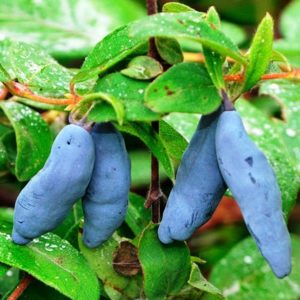
Also, when choosing a variety, it is recommended to pay attention to the plant’s immunity to fungal and viral diseases. Common diseases of honeysuckle are ramularia (white spot), powdery mildew, and sooty fungus.
To increase the resistance of the plant, summer residents spray the bushes with a solution of Bordeaux mixture or copper sulfate, regularly remove weeds and loosen the soil.
Honeysuckle requirements also matter to care. If the variety is sensitive to the composition of the soil, the plant will need constant feeding.In central Russia, not all lands are nutritious, so it is recommended to choose honeysuckle that is undemanding in terms of planting site and special care.
A selection of the best varieties for the middle zone
The experience of other gardeners helps you choose the right variety - you can find a lot of reviews about each crop on the Internet: how often the plant gets sick, how it behaves during the fruiting process, how the fruits grow.
Also, before planting, it is recommended to study our rating of the best varieties - compare their merits, productivity, early fruiting and other characteristics.
Blue spindle
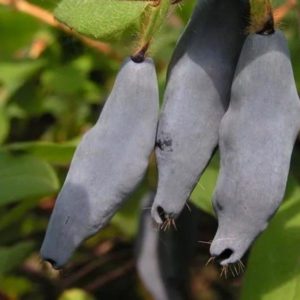
One of the popular varieties of Russian honeysuckle. Early ripening, universal in use. The bushes are compact, medium-sized, and take up little space on the site. The variety got its name due to the spindle-shaped berries. The color is black with a thick blue coating, the skin is strong, the berries do not crack after ripening. The average weight of the fruit is 0.9 g, the taste is sweet and sour with bitterness.
Honeysuckle Blue spindle bears fruit for 30 years and is resistant to diseases and pests. In central Russia, the harvest is harvested already in June, when other berries are in the flowering stage.
Long-fruited
Long-fruited bushes are weak-growing, the shoots are thin and purple in color. The plant is winter-hardy and resistant to shedding. Blue berries are distinguished by their elongated shape, the surface is slightly lumpy. The stalk is thin, the skin is medium thick. The weight of the berry is about 0.8 g, the taste is pleasant, sweet with a refreshing sourness.
To increase productivity, other pollinating varieties are planted next to Long-fruited. The berries are suitable for fresh consumption and processing, drying and freezing.
Tomsk
Winter-hardy early ripening variety Tomsk unpretentious in cultivation. The bushes are medium-sized, the shoots are thin.The berries are black with a blue waxy coating, elongated in shape with a depressed top, average weight 0.8 g. The taste is sweet and sour, the flesh is tender and juicy.
Tomskaya begins to bear fruit in the fourth year after planting; up to 2 kg of fruits are collected from the bush. The fruits are used for baby and dietary food, canned and ground with sugar.
Interesting! An easy way to process honeysuckle and preserve its beneficial properties is to make a puree. The berries are ground with sugar, placed in glass jars and stored in a cool place. Another way to preserve the crop is drying. The berries are laid out in one layer on a baking sheet, placed in the oven at a temperature of 60°C, and stirred occasionally.
Blue bird
An early-ripening, high-yielding variety ripens by mid-June. The fruits do not fall off, are rarely damaged by insect pests, and are suitable for transportation and storage. The plant is low, the shoots are slightly spreading. The berries are oval, weighing about 1 g, black-blue in color with a thick waxy coating. The taste is pleasant, sweet and sour. The productivity of Bluebirds increases due to the introduction of mineral fertilizers - ammonium nitrate, nitrogen-containing substances.
The variety is planted on nutritious soils with neutral acidity - otherwise the yield will decrease.
The Giant's Daughter
The mid-late variety of honeysuckle, Giant's Daughter, is universal in use. The plant is planted in spacious areas - vigorous bushes require a lot of free space. The berries are drop-shaped, elongated, weigh about 2 g. The color is blue-violet with a waxy coating, the peel is dense. The taste is pleasant, sweet and sour, the aroma is refreshing.
Tasting score of the variety is 4.8 points. The variety is not affected by powdery mildew or white spot, and is protected from wasps and spider mites.Drought resistance is average, frost resistance is high.
Altair
The bushes are medium-sized, the crown is rounded. The shoots are straight with slight pubescence, the leaves are oval. The ripening period is average, the harvest is harvested in early or mid-July. The berries are blue-blue, weight about 9 g, elongated in shape. A strong waxy coating protects the berries from rot; the crop hangs on the bushes for a long time after ripening and is used for transportation and storage. The pulp is tender, pleasant to the taste, aromatic, sweet and sour.
Taste rating: 4.4 points. Altair is resistant to low temperatures. Honeysuckle is grown for personal use and sale.
Blue dessert
Mid-early variety, harvested at the end of June. The density of the bushes is average, the shoots are brown-red, straight and thin. The shape of the berries is drop-shaped, weight is about 0.8 g. The skin is thin, the taste is sweet, without bitterness.
Tasting score for the Blue dessert: 5 points. The variety is not affected by fungal and viral diseases, quickly adapts to the climatic conditions of the region, and is resistant to fruit shedding. The berries are eaten fresh or processed. Honeysuckle jams and preserves are added to muffins, pies, pies, and pancakes.
Interesting! Suitable planting material is two-year-old seedlings. Before planting, add 300 g of lime per 1 square meter to the soil. m. Liming reduces the acidity of the soil. Afterwards, a hole is dug with a diameter of 60 cm and a depth of 40 cm. It is fertilized with manure, peat, potassium salt and superphosphate.
Highlight
Bushes near Highlights medium-sized and slightly spreading. The shoots are curved, purple in color, slightly pubescent. The berries are elongated, weighing about 1.1 g, blue with a bloom.
The taste is sweet, without sourness or bitterness, rating 4.8 points. The variety is early-bearing, the harvest is harvested 2-3 years after planting.One bush annually produces up to 3 kg of tasty and juicy fruits. The variety requires pollinators to bear fruit. Zest grows quickly in shade or partial shade and is undemanding to soil composition.
Early varieties of honeysuckle for central Russia
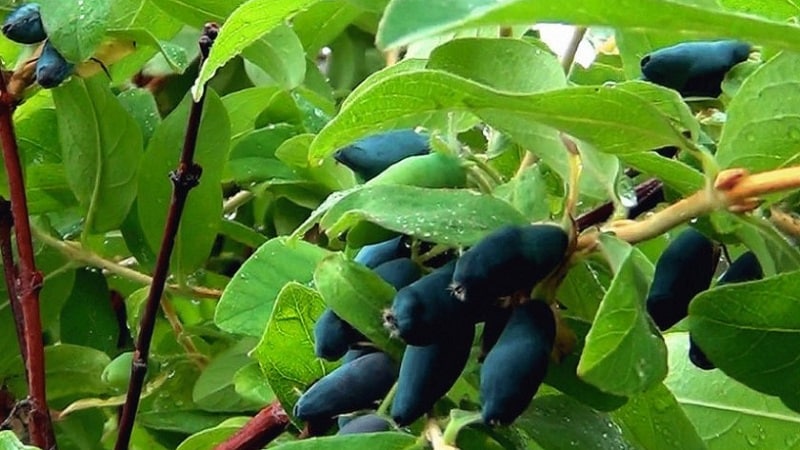
The early harvest of honeysuckle is used for fresh consumption and processing. The berries are harvested in early June. Of the early ripening varieties, it is recommended to pay attention to Kasmala. The bushes are compact, medium-sized. The leaves are pale green, ovate, matte. The berries are violet-blue, round, average weight 1.2 g. The skin is thin with a waxy coating without pubescence. The pulp is sweet and sour, juicy and aromatic.
The tasting score of the berries is 4.9 points. Kasmala is winter-hardy and does not require special skills to grow.
Another popular early variety is Minusinskaya Sineva. The bushes are medium spreading with straight shoots. The leaves are dark green, the flowers are large. The berries are dark blue, rich in color, weigh about 0.8 g, the skin is strong, with a waxy coating. The variety is resistant to drought and insects, early-bearing - the harvest is harvested in the third year after planting. One bush produces about 2 kg of fragrant fruits.
Late ripening
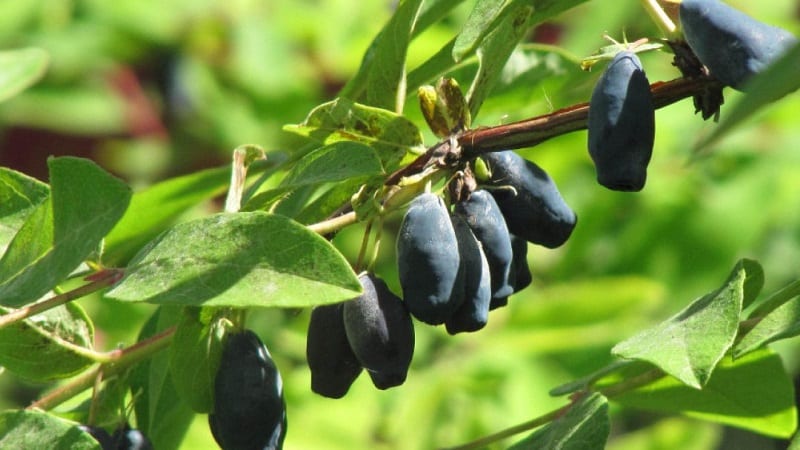
Late honeysuckle ripens in late July - early August. Berries are not only eaten fresh or processed, but also dried, transported, and sold.
Of the late varieties, Provincialka honeysuckle is distinguished. The bushes are weak-growing, the shoots are curved, without pubescence. The berries are large, the average weight of one is 1.9 g. The shape is elongated-oval, the color is dark blue with a thick waxy coating. Provincialka bears fruit 3-4 years after planting and needs pollinators. The pulp is tender and aromatic, the taste is sweet and sour, without bitterness. Taste rating: 5 points. The crop is grown for sale: the berries tolerate transportation well.
The late variety Stoykaya is also noted. Honeysuckle is not affected by powdery mildew and white spot, and is immune to pests. The bushes are vigorous with matte thick shoots. The berries are oval-lumpy, weighing about 0.8 g. The color is blue with a waxy coating. Tasting score 4.2 points, taste sweet and sour with a slight bitterness. Application of honeysuckle Persistent universal.
Other options
In addition to the timing of ripening, gardeners pay attention to such characteristics as fruit size, taste, and pollination. Some prefer self-fertile varieties, while others prefer sweet and harmonious taste.
The largest-fruited
The average weight of one berry is 1 g, but some varieties delight summer residents with berries weighing 2 g or more. These fruits are ideal for fresh consumption, canning, drying and freezing.
The following varieties are distinguished from large-fruited ones:
- Yugana. The weight of the berry reaches 1.8 g, the shape is pitcher-shaped. The color is blue with a bluish waxy coating, the skin is medium thick. The taste is sweet with a pleasant refreshing aroma. The ripening period is average, the purpose is universal, winter hardiness and immunity to diseases are high.
- Bakchar giant. The bushes are vigorous and spreading. The berries are oval, blue in color, average weight 1.9 g. The skin is medium thick, with a waxy coating. The pulp is tender, sweet and sour, without bitterness. The Giant is not afraid of diseases and pests.
- Atlant. The mid-season dessert variety is universal in use. Early fruiting, harvested in the third year. The weight of the berry reaches 1.5 g, the surface is lumpy, and the shape is oval and elongated. The taste is sweet and sour, the aroma is delicate. Jams and preserves are made from honeysuckle, and the fruits are added to ice cream or milkshakes.
Self-pollinating
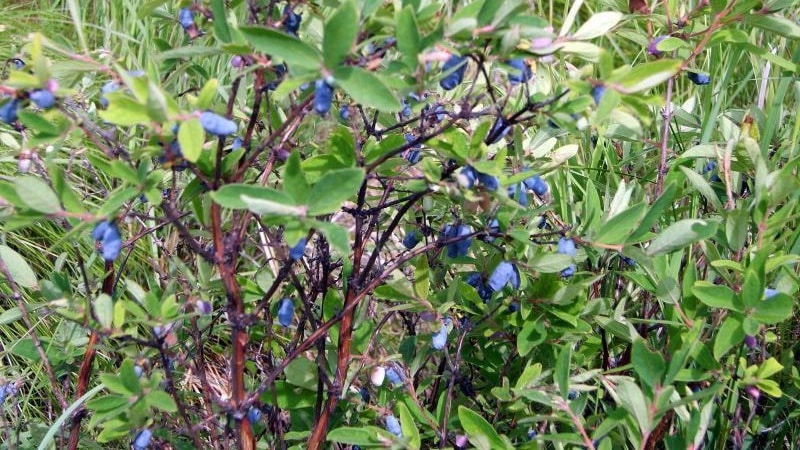
Self-pollinating varieties do not require pollinating insects or other honeysuckle varieties in the neighborhood. This makes caring for the plant easier and does not require artificial pollination.
Among the self-pollinating varieties, the following stand out:
- Nymph. The ripening period is mid-early; gardeners harvest in mid-June. The bushes are medium-sized, the shoots are thick and straight, there is slight pubescence. The flowers are white-yellow, medium size. The weight of the berry is 0.8 g, the shape is spindle-shaped, the color is dark purple with a blue coating. The pulp is sweet and juicy, with a rich berry aroma.
- Siberian. The berries are blue-blue, weight 1 g. The taste is pleasant, tasting score 4.9 points. There is a waxy coating on the surface that protects the fruit from rot. Sibiryachka's bush is medium-sized. The variety is resistant to frost and is not damaged by wasps and aphids. Suitable for fresh consumption and transportation, unpretentious in cultivation.
The sweetest
The sweet and aromatic pulp will delight every gardener. These berries are good in any form, be it jam or sugar puree.
The taste of the fruit is harmonious, juicy and delicate:
- I have a sweet tooth. The bushes are weak-growing, the shoots are brown and thick. The berries are oval in shape, blue in color, thick skin, weight about 1 g. The pulp is pleasant to the taste, tasting score 5 points. Slastena is slightly affected by powdery mildew and rot, and does not fall off after ripening. Suitable for growing in summer cottages and garden plots.
- Nightingale. The bushes are medium-sized, early-bearing - gardeners collect the first harvest 2-3 years after planting. The berries are blue-blue with a bloom, the shape is elongated, spindle-shaped, the flesh is tender. The taste is sweet, balanced, rating 4.6 points. The nightingale is suitable for industrial cultivation.
- Lapis lazuli. Mid-season variety, universal in use.The berries are purple, elongated oval in shape. The weight of the fruit is 1.4 g, the taste is sweet and delicate. The skin is thin but durable and protects the honeysuckle from cracking. Another advantage of the variety is its resistance to low temperatures.
Recommendations for choosing a variety
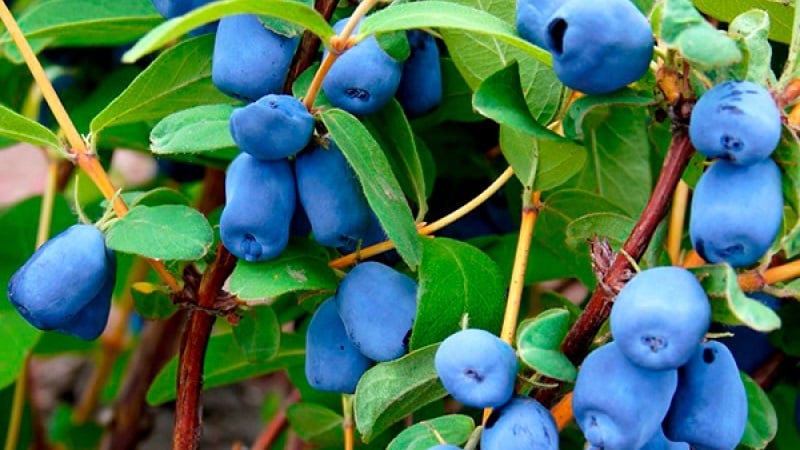
When choosing, take into account the ripening period. In warm regions, early-ripening varieties are grown, in cooler regions, late-ripening varieties are grown. It is recommended to pay attention to early fruiting - most gardeners prefer varieties that produce a harvest within 3-4 years. There is honeysuckle, which bears fruit only in 5-7 years.
It is important to take into account the taste and commercial qualities of the fruit, and study reviews from other gardeners. Sweet honeysuckle is grown for fresh consumption; the size of the fruit does not matter. For processing, storage or sale, it is recommended to plant large-fruited honeysuckle with resistance to cracking.
Attention! For planting in small areas, choose compact, slightly spreading bushes - they take up little space and do not block other plants.
Conclusion
Blue spindle, Giant's Daughter, Blue Bird - the most popular varieties of edible honeysuckle for planting in central Russia. They are valued for their ease of cultivation, early fruiting, sweet taste, and frost resistance. This honeysuckle rarely gets sick and is not damaged by insect pests.
Also distinguished from the varieties are large-fruited honeysuckle Atlant and Yugan, self-fertile Sibiryachka and Nymph, sweet Lazurit and Nightingale. Thanks to the waxy coating, the berries are stored for a long time and do not lose their taste and commercial qualities.